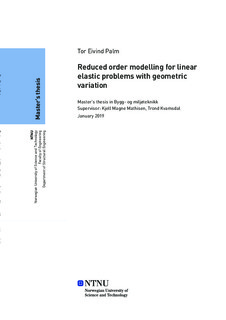| dc.contributor.advisor | Kjell Magne Mathisen | |
| dc.contributor.advisor | Trond Kvamsdal | |
| dc.contributor.author | Palm, Tor Eivind | |
| dc.date.accessioned | 2019-10-15T14:00:41Z | |
| dc.date.available | 2019-10-15T14:00:41Z | |
| dc.date.issued | 2019 | |
| dc.identifier.uri | http://hdl.handle.net/11250/2622340 | |
| dc.description.abstract | Formålet med denne oppgaven er å undersøke bruken av reduserte modeller for å løse parametriske partielle differensialligninger. Dette vil bli gjort ved å konstruere og analysere reduserte modeller innen konstruksjonsmekanikk med elementmetode-modeller som utgangspunkt. Spesiell vekt legges på hvordan de reduserte modellene skal konstrueres og dere oppførsel med hensyn til geometriske parametre. De grunnleggende aspektene for reduserbare problemer er gitt i introduksjonskapittelet, og beskriver motivasjon for reduksjon og en skissering av oppgaven.
For å oppnå målet med oppgaven ble det gjennomført et litteratursøk. Først presenteres det teoretiske grunnlaget for elementmetoden i Kapittel 2, som beskriver nøkkelbegrepene samt gir en mer praktisk innføring i lineær elastisitet innen konstruksjonsmekanikk. Teori om reduserte modeller presenteres i Kapittel 3, som forklarer bakgrunnen for reduksjon, nøkkelforutsetninger og fremgangsmåten for å bygge en redusert modell gjennom projeksjonsmetoder.
Basert på denne teoretiske bakgrunnen ble det gjennomført en numerisk studie på to eksempelproblemer som har som mål å undersøke oppførselen av de reduserte modellene. Eksplisitt uttrykk for det lineær elastiske tilfellet ble utledet og implementert, og den nødvendige Python-koden finnes i tillegg B.
For begge eksemplene ble reduserte modeller konstruert med tilfredsstillende ytelse, men to nøkkelresultater dukket opp. Den første er numerisk støy i den reduserte modellen som viste seg å være forbundet med nettopp geometrisk parametrisering. Geometrisk variasjon påvirket likevekt ved grensebetingelsene, og den reduserte modellen hadde problemer med å fange opp denne oppførselen. Effekten av dette viste seg å være ubetydelig i dette tilfellet, men det kan vise seg å være viktig hvis denne tilnærmingen blir brukt på mer komplekse systemer.
Det andre funnet dreier seg om hvordan antagelsen om affinitet med hensyn til parametere som muliggjør reduksjon, og hvordan dette påvirker konstruksjonen av elementmodellen. På grunn av det kompliserte forholdet mellom elementmodellen og geometriske parametre resulterte dette i å forandre hvordan elementsystemet ble konstruert, noe som divergerte sterkt fra den generelle fremgangsmåten som vanligvis finnes i eksisterende elementmetode-programvare. Dette påvirker bruken av reduserte modeller ettersom spesialtilpasset elementmetode-programvare blir en nødvendighet. | |
| dc.description.abstract | The purpose of this thesis is to explore the use of reduced order models for solving parametric partial differential equations. This will be done through constructing and analyzing reduced models within the field of structural mechanics with finite element models as starting point. A special emphasis will be put on the construction and behaviour of reduced models with respect to geometric parameters. The fundamental aspects of reducible problems is given in the introductory chapter, describing motivation for reduction and outline of the thesis.
In order to achieve the thesis goal, a literature review was done. Firstly the theoretical foundation of the Finite element method is presented in Chapter 2, outlining the key concepts of this approach as well as more practical derivations for the case of linear elasticity in structural mechanics. The theory of reduced order models is then presented in Chapter 3, explaining the background for reducibility, key assumptions and the approach of constructing a reduced model through reduced bais projection methods.
Based on this theoretical background a numerical study on two example problems was implemented which aimed to explore the over all performance of the reduced models. Explicit expression for the linear elastic case was derived and implemented, and the necessary python code can be found in Appendix B.
For both examples reduced order models where created with overall satisfactory performance, however two key finding from the numerical study emerged. The first being numerical noise in the reduced model that proved to be associated with geometric parametrization. As geometric variation affected the equilibrium of the supported boundary, the reduced model had problems capturing this behaviour. The effect of this turned out to be negligible, but might prove to be of importance if this approach is applied to more complex systems.
The second finding revolves around the assumption of affinity with respect to parameters in order to ensure reducibility, and how this influence the construction of the full order model. As a result of a complicated connection between finite element model and geometric parameters this meant altering the assembly of the finite element system, diverging greatly from the general approach usually found in existing finite element software. This impacts the applications of reduced order models as customized finite element software becomes a necessity. | |
| dc.language | eng | |
| dc.publisher | NTNU | |
| dc.title | Reduced order modelling for linear elastic problems with geometric variation | |
| dc.type | Master thesis | |
